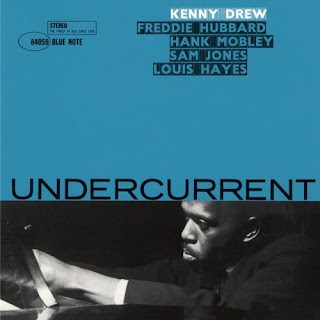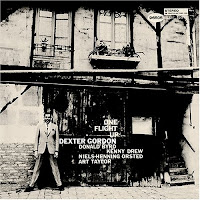Pianist Kenny Drew's second and final Blue Note session as a Leader turns out to be perhaps more famous to jazz record collectors for being the last original deep groove Blue Note pressing.
What gets lost in the shuffle sometimes is what a fantastic record it is, seems an awful lot of the time the music takes a back-seat to the collecting minutia in Blue Note collecting circles.
As a collector myself, I get a little irritated when the focus strays so far away from the actual music. Recorded in December of 1960, and released in 1961, Undercurrent is a typical hard bop date for the label with a handful of swinging cookers, a ballad, and a blues.
However: Undercurrent is no ordinary record, you have the ballsy trumpet of Freddie Hubbard, and the sweet lyricism of tenor man Hank Mobley matching whits throughout. Both create some of finest unison playing you will hear on Blue Note.
Of course Kenny Drew's piano is delightful, and is out front in the mix, thanks to a very good Rudy Van Gelder engineered recording. The CD remaster I am listing to as I write does sound sweet, doesn't sound inferior to many vinyl copies I have heard over the years; a very crisp and clean sound, with perfect balance.
Boy do I like Mobley on "Groovin the Blues", sounds like something you could have heard on Mobley's masterpiece Soul Station, save Hubbard's trumpet of course, that being a quartet recording like it is. Drew also plays some of the tastiest blues n bop runs you'll hear.
"Ballade" is a lovely romantic Drew composition, again Hubbard's horn and Mobley's tenor pair up for a wonderful set of down tempo verses. Then Drew takes over with a nice melancholy ride with the brushes of Louie Hayes and the light walking bass of Sam Jones.
Then Hubbard and Mobley playfully trade off a little, then an abrupt end that leaves you wanting more, a fantastic ballad all the way around.
The title track is aptly titled, as the piano and drums create a nice little bubbling under the surface "Undercurrent" if you will, the horns spar over top this quick Blakey styled tune. Freddie Hubbard really reminds me Clifford Brown here, perhaps the mood and quick pace causes this.
Also, Mobley never seems to run out of ideas, his playing is strong, it's actually a little more bombastic than normal. Probably not easy to keep up with Freddie Hubbard, but Hank does a great job here.
I used to think Mobley was overrated, albums like this and his own Soul Station won me over fairly quickly, I always wondered why he never fit well in Miles Davis Band after Coltrane left? It's one of the biggest mysteries to me?
I think overall Undercurrent is one of the real great Blue Notes, and belongs in every jazz collection. A fairly hard vinyl record to find, even vintage reissues, if you must have a vinyl copy you might check out the 45 rpm Music Matters reissues, I hear the stereo sound on these is stellar.
What Are Jackie McLean Blue Note Records Selling For?
-
Prices rising, but still affordable? If you have been collecting Blue Note
records for a while, you are aware of how much Jackie Mclean vinyl is
selling fo...









